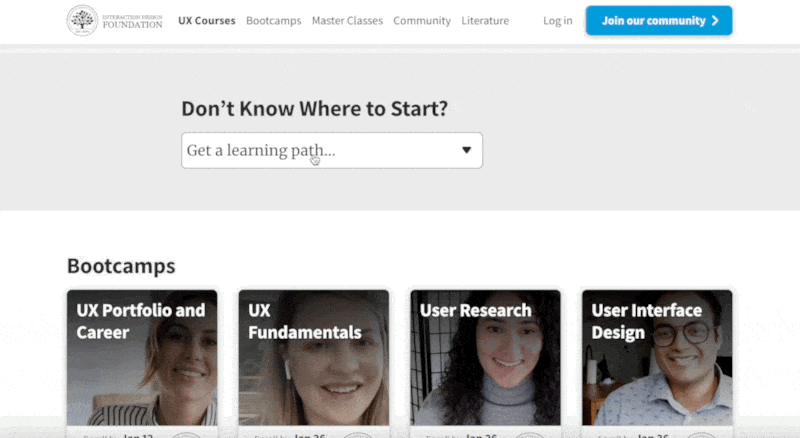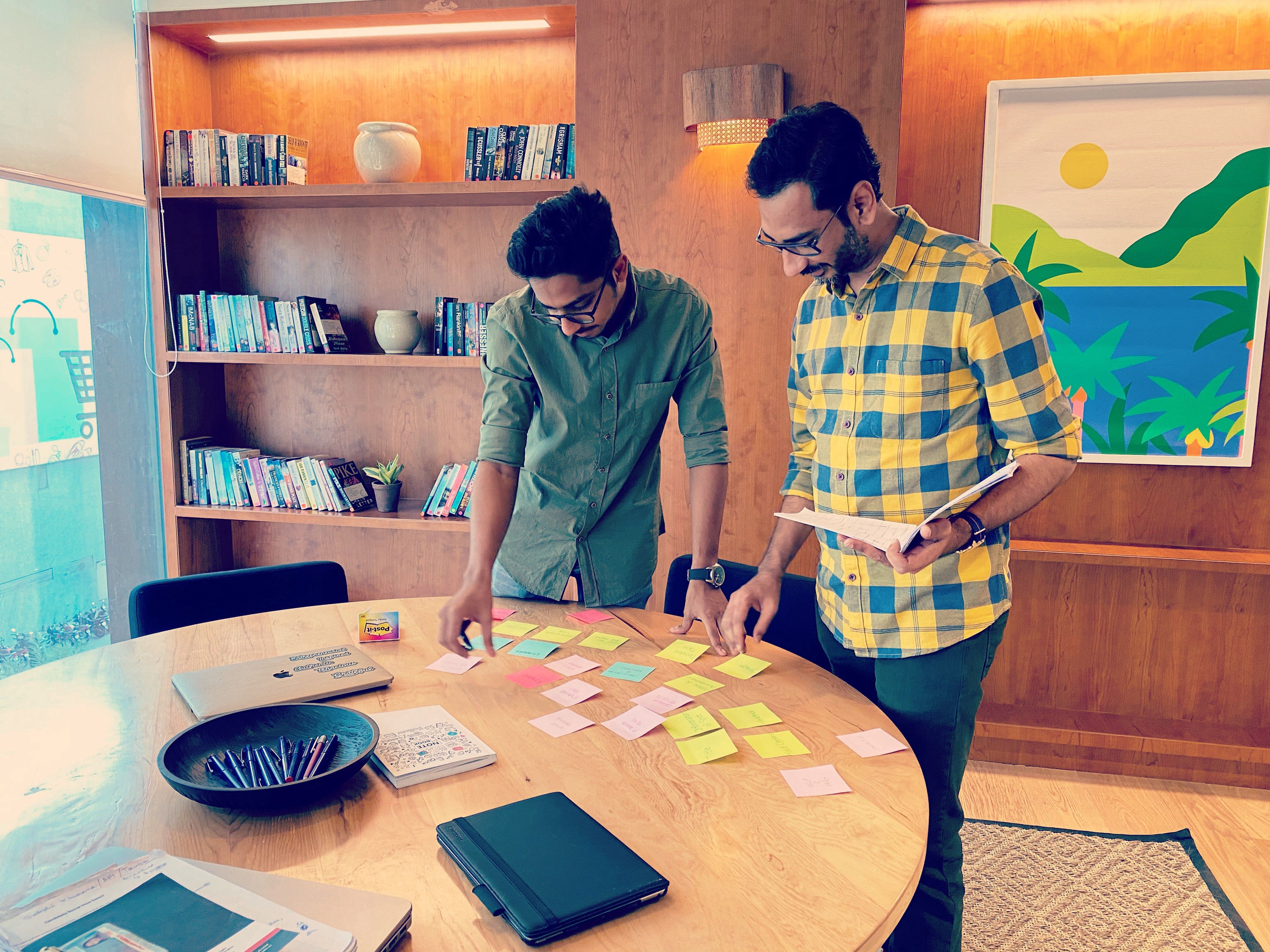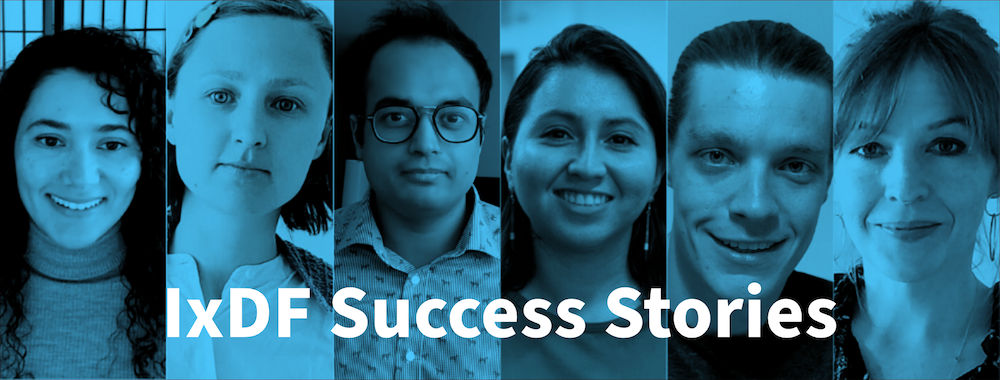Switching careers—regardless of whether you’re forced into it due to circumstances or not—is tough. Upskilling, hunting for jobs without prior industry-relevant experience and establishing oneself from scratch requires time, effort and in most cases, significant financial investment. If you’re considering switching careers, know that you are not alone. Many past members of the Interaction Design Foundation (IxDF) have been in similar situations. And many have crossed that bridge successfully. Here are just a few examples of real IxDF members who successfully landed a job in UX; we hope this inspires you to take the leap in 2025!
Step 1: Discovery—Why Switch to a Career in UX Design?
Everyone has a different reason for switching careers. For some, it is out of necessity—health, or family-related; many people joined the IxDF after industry-wide layoffs during the Covid-19 pandemic. For others, it revolves around a sense of purpose. And for some, a career switch happens gradually, or even by accident. Many of our members discovered UX as an ideal career path either because their current career offered easy pathways to UX, or because UX celebrated personality traits like empathy and creativity.
One of our members, Luigi Cotini is a registered psychologist in Rome who has now almost completed his transition into UX design. As a university student, when 99% of his peers either wanted to become therapists or work in HR, Luigi felt that those professions were not suited to his interests.
“...those were things that I certainly took into consideration too, but at the same time they did not ignite the spark in me.”
— Luigi Cotini
Despite not wanting to follow the beaten path, he ended up becoming a psychologist and then decided to switch careers. Luigi is one of the thousands, if not millions of people around the world who have decided to or are currently contemplating switching careers. As per a survey by Indeed, nearly half (49%) of the workforce in the US has made a drastic career switch. And of those who hadn’t made such a shift, 65% said that they were either actively considering it, or had previously thought about it. For Luigi, that attempt at a career change started with an idea to set up his own business. He realized in the nick of time that it was both an expensive and risky venture.
“I wanted to find an innovative and uncommon job, where I could express my creativity in a practical way and where my psychology background would have been useful in some way. So I discovered user experience design and soon I realized that it was the perfect solution for me.”
— Luigi Cotini
Robert Ruediger began his career as a travel agent before transitioning into an English language teacher. He confessed that he has always struggled to find a concrete career direction. He found out about UX design after he took a personality test that included career recommendations.
“There it was, eight black letters on a white computer screen that would change my life forever: “UX Design”.
My independent research made me realize there were three ways I could try to make this change. The first was through a proper university or design school but as an expat in his 30’s who already has enough student loan debt, this didn’t seem feasible. There was a lot of content from those ambitious self-starters I envy so much about how they taught themselves to be UX Designers successfully, but a common thread was their previous experience with some design or tech-related field which I lacked. Finally, boot camps were the topic of hot debate on nearly every forum that UX career change discussions were taking place.”
— Robert Ruediger
Another IxDF member, Tania Zgerya, decided to switch after a decade in the fashion industry. She had grown tired of the “crazy pace” of her work and having just had her first baby, she began looking for something new.
“Switching to a new field and starting a new career can be very intimidating, thus I looked for an online platform where I could learn without losing sleep or end up bankrupt. There are many platforms and online courses that promise to teach you everything you need in order to land a job in UX, but most of them are too expensive and very intense. As I didn’t have the time, I couldn’t take that risk. My needs were different. Yes, I wanted to become a UX designer as fast as possible, but I needed to do it on my own terms. That’s when I stumbled upon the Interaction Design Foundation.
It was actually too good to be true. With a relatively small yearly fee, I got access to Ivy League design education! There, I could choose my own path and complete it at my own pace. I didn’t have much to lose, so I paid the fee and prepared to begin my first course.”
— Tania Zgerya
Luigi, Robert and Tania scoured the web, and ultimately chose to become IxDF members for similar reasons: high-quality, affordability, and the self-paced nature of the courses. Each chose a different path to learning and discovered that they could easily relate to the concepts from the courses.
Step 2: Finding Common Ground—Carry Forward Your Past Experience into Your New Career
UX design is one of the friendliest professions for people transitioning from a different career. No matter what your background, you are sure to find common ground and your skills and past experience will always be handy.

UX design is a vast field that can easily overwhelm a newcomer. The IxDF’s learning paths are carefully designed to guide you in your journey, depending on your end goal.
While Tania chose the UI designer learning path, Luigi’s background in psychology led him to choose specific courses that matched his training:
“...there is much more psychology in UX design than you can imagine, “I finally see Gestalt psychology finding its practical application.” I thought when I started studying these disciplines, and I also thought about how I finally have found something I really like to learn and that is going to lead me to a job where my psychological studies meet my creativity and my passion for design, technology, and innovation.”
— Luigi Cotini
Robert also found himself relating UX design with his past avatar as a travel agent:
“So far I have completed the User Experience: The Beginner’s Guide course. It was fantastic for learning how to adopt a “Design Thinking” mindset and showed me how the skills I gathered as a travel agent and a teacher are very applicable to the world of UX Design. Now, I am building the foundations of my visual design skills with the UI Design Patterns for Successful Software course, which has already improved my application of visual hierarchy and my wireframes drastically.”
— Robert Ruediger
Tania’s learning path took her through design thinking, before moving on to UI Design Patterns for Successful Software. After a few weeks of studying, she could see the theory in practice:
“Ever since I took this course, I can no longer look at websites or apps as I did before. Now, I analyze them; what works, what doesn’t work, I notice the location of each component and the reason for it, and I think how it might be improved. My day-to-day digital experience has evolved into a new level…
My next step is to create a portfolio and start looking for a position as a UX Designer. I’m super optimistic and full of excitement to start this new chapter in my career.”
— Tania Zgerya
Step 3: Build a Stellar Portfolio
A portfolio is crucial for successfully transitioning to UX design, something that all three—Luigi, Robert and Tania realized early on and are working their way towards. While they are just entering their UX careers, Satyen Aghor faced a diametrically opposite problem. A freelance designer who’s been in the industry since the year 2000, he taught himself all the ropes even as the industry was evolving in front of his eyes.
Despite having worked for clients worldwide, he felt unsure:
“For most of the time in my career, I practised self-learning as there were no trusted (re)sources available or they were out of reach from money, time or distance perspective.
There came a time when I really needed to break the spell of practicing what I knew. I wanted to go beyond what is been asked and expected. Even if what I was doing was right, I needed a concrete theory and a basis to prove my design decisions."
— Satyen Aghor
He completed the “User Experience: The Beginner’s Guide” course and started applying UX practices to his projects.
“The websites started looking and performing better. The result was more work, more money, more satisfaction and better life… I wanted to write a case study but how to go about it was a mystery… IxDF again became my saviour with “Build a Standout UX/UI Portfolio: Land Your Dream Job” course and I could be a better storyteller and come up with an awesome case study.”
— Satyen Aghor

Satyen (right) connected with fellow IxDF members offline through local groups and worked on projects with them.
© Satyen Aghor, used with permission.
Step 4: Networking
Like Satyen, many IxDF members cherish the real connections and the network they are able to build through local groups.
“Aside from the courses, IxDF’s community of professional designers, students, and career-changers like me create a warm and inviting atmosphere of support. There are communities devoted to cities all around the world that organize meetups and carry on discussions about trends and news in their area.”
— Robert Ruediger
Adesh Shah explains the importance of networking, and the benefits he’s been able to reap—getting his current job—from IxDF local groups, in this video:
Step 5: Getting the First UX Client
A stellar portfolio and smart networking can help you get a foot in the door.
Before becoming a UX designer, Su Wiemer was a brand and web designer. She shares her tips on how to gain practical experience, learn by doing and build a portfolio in the process.
“Through an existing client, I had the opportunity to start my first UX/UI project without any practical experience or portfolio. This allowed me to quickly get into practical work as well, and I am very grateful for that.
If you don’t have this opportunity, don’t worry. Alternatively, you can gain practical experience in internships, as a volunteer, or a trainee. In addition to theory, this is an important step towards becoming a UX designer.
Of course, a good portfolio isn’t done in a few hours. If you need help, I can warmly recommend the course “Build a Standout UX/UI Portfolio: Land Your Dream Job” at the IxDF. Here you will learn how to put everything together to create a winning portfolio.
Alternatively, if you have no work experience and a lack of projects for the case studies, there are 3 courses at IxDF with realistic UX project briefings that you can build portfolio projects on:
— Su Wiemer
Step 6: Continuing Education
Like Su and Satyen, Laura Escobar too jumped into the deep end by taking up UX projects without any UX training. Laura got her first project as a freelancer through a friend while she was still in university and did not know anything about UX design.
“When I was just starting the university, career pivoting was a foreign concept for me. We’re taught from a young age that what you study in the university will be determinant of who you become, but as the years went by, I found more and more people switching gears to something that made them happier than their original plan, and it was totally ok.”
— Laura Escobar
To gain the necessary skills to switch careers, Laura adopted a strategy of extensive reading, learning on the job and experimenting. As she took on more challenging roles and began working with a team, she realized the need to take specialized UX design courses and tune into talks and podcasts to gain the skills needed to work as a product designer. Now, as a business leader, her learning strategies have evolved to become more selective and focus more on community.
“I could list all the reasons why joining a community can push you forward in your career, but the single main difference it did for me was teaching me how everyone has something to offer and areas where you can help just as well.”
— Laura Escobar
Having gradually moved from UI design to product design to a leadership role, Laura advocates continuing education.
“When we’re in the university, we usually think that 5 years of studying is everything we need, and we couldn’t be more wrong. As we progress in our careers, we start deviating to specific areas that aren’t even close to what we studied in our initial years, and that’s why the university is merely our first step of many into what hopefully becomes a fulfilling career.
In my case, Graphic Design taught me the fundamentals of design, but it lacked most of the nuances that come with the Product Design field. That’s why I knew that taking courses in specific topics would help me to dig deeper and develop new skills.
After doing some benchmark research I came across the Interaction Design Foundation (IxDF), an online school with self-paced courses at an affordable price. Its content has been crafted by industry experts and it’s suitable for all levels and roles…
You may not need a brand new dashboard, gamification techniques, or Usability Testing in your current project, but you’ll certainly do at some point (it happened to me many times), so it’s better to be safe than sorry.”
— Laura Escobar
The Take Away
The decision to switch careers isn’t easy. For some—like Luigi Cotini and Robert Ruediger—it is to gain a sense of purpose. For others, like Tania Zgerya, life circumstances forced the decision. And for still others, like Su Wiemer and Laura Escobar, it is a combination of serendipity and gradual shift. No matter what spurs your decision to switch, transitioning to a new career can be a daunting task. Our members have consistently shown us that not only can you switch to a career in UX successfully, but it is also a highly rewarding, self-fulfilling journey that you can pursue at your pace and without breaking the bank.
Su Wiemer sums it up perfectly:
“If you really want it, a career transformation to UX design can be achieved (even though it will probably take more than a few weeks). Take the time you need and take it one step at a time, it will be worth the wait.
I love my work now more than ever, and I have doubled my earnings. So it’s easy for me to say: all the effort has paid off.
I’m sure there are many other good design schools and training programs out there (such as the Norman Nielsen Group, for example). But in my case, the IxDF was able to guide me through all the steps I needed. Through the IxDF, I learned so much and was able to transform my career–and for that I am very grateful.”
UX design is one of the most friendly professions to enter. Unlike most other professions, you will find your previous experience, especially soft skills, is transferable. So, even if you don’t have a formal design background, skills such as communication and problem-solving ability will give you an edge. Start by taking online courses, attending webinars, reading and listening to experts. Forming professional networks offline, working on projects and building a portfolio is crucial to getting your first job in UX Design. As technology continues to evolve and new opportunities emerge, make sure you continue to stay updated with the industry.
References and Where to Learn More
We asked hiring managers what they look for in UX designers. Here’s what they told us.
UX design is a vast field. Here’s a cheatsheet into every UX role out there, and which one you should go for.
Let’s settle the debate once and for all. The answer to the question, “Should UX designers learn to code?”
Still not sure if a career in UX design is right for you? Check out this piece to know more.
Here are detailed guides on how to switch a career to UX design if you’re currently in any one of the following professions:
Laura Escobar gives a detailed breakdown of her path to product design, in a three-part essay. Go on a journey of serendipity and continuous learning here: The Journey of Being Self-taught
Su Wiemer shares her tips and strategies for freelance designers: How I Doubled My Freelance Income As a UX Designer
Tania Zgerya has made studying UX a part of her daily life. Here’s her experience, one year in: Learning UX Design with the Interaction Design Foundation — A Review
Robert Ruediger’s road to UX design is filled with twists and turns. Read more here: How Interaction Design Foundation Has Been Crucial to My UX Design Career Change-A Review
Luigi Cotini sees himself continuing to study even after gaining experience Here’s why: How I Am Becoming a UX Designer Thanks to the Interaction Design Foundation — a Review
A veteran freelancer, Satyen Aghor recounts how he gained confidence in himself and the impact it had on his work: Learning UX Design with the Interaction Design Foundation — a review
(Some of the quotes in this article have been modified to reflect changes made to IxDF course offerings since the members wrote their articles.)












